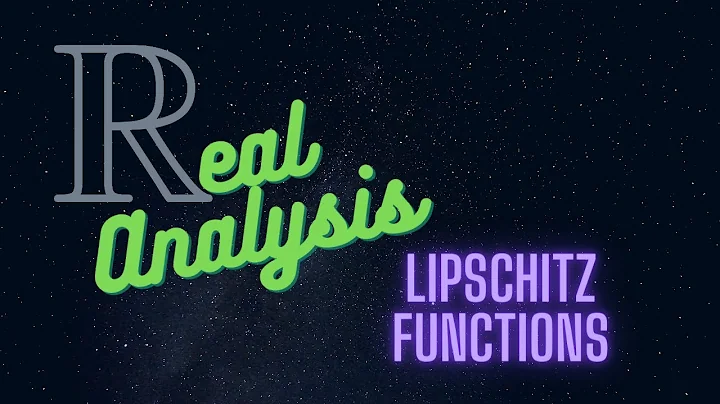Are All Continuous Functions Locally Lipschitz
The definition of locally Lipschitz
A function $f\colon A \to B$ is locally xyz if every point $x \in A$ has a neighbourhood $U$ such that $f\lvert_U$ is xyz. (For things like local homeomorphisms, one has to also consider a neighbourhood of $f(x)$, but for locally Lipschitz, only the restriction of the domain is relevant.)
$f\colon A \to \mathbb{R}^m$, where $A\subset \mathbb{R}^n$, is (globally) Lipschitz-continuous, if there is a constant $L \geqslant 0$ with
$$\bigl(\forall y,z \in A\bigr)\bigl(\lVert f(y)-f(z)\rVert \leqslant L\cdot \lVert y-z\rVert\bigr).$$
$L$ is called a Lipschitz constant for $f$. An equivalent definition is that
$$L_f := \sup \left(\left\lbrace \frac{\lVert f(y)-f(z)\rVert}{\lVert y-z\rVert} : y,z \in A, y \neq z\right\rbrace \cup \{0\}\right) < \infty.$$
$L_f = 0$ if and only if $f$ is constant.
Thus $f \colon A \to \mathbb{R}^m$ is locally Lipschitz-continuous, if every point $x_0 \in A$ has a neighbourhood $U$ such that $f\lvert_U$ is Lipschitz-continuous. Since the open balls with centre $x_0$ form a neighbourhood basis at $x_0$, that is equivalent to
$$\bigl(\forall x_0\in A\bigr) \bigl(\exists \delta_0 > 0\bigr)\left(L_{f;x_0,\delta_0} < \infty\right),$$
where
$$L_{f;x_0,\delta_0} := \sup \left(\left\lbrace \frac{\lVert f(y)-f(z)\rVert}{\lVert y-z\rVert} : y,z \in A, \lVert y-x_0\rVert < \delta_0, \lVert z-x_0\rVert < \delta_0, y\neq z\right\rbrace \cup \{0\}\right);$$
or that for all $x_0 \in A$ there exist constants $\delta_0 > 0$ and $M_0 \geqslant 0$ ($\delta_0$ depending on $x_0$, and $M_0$ depending on $x_0$ and $\delta_0$) such that
$$\bigl(y,z\in A, \lVert y-x_0\rVert < \delta_0, \lVert z-x_0\rVert < \delta_0 \Rightarrow \lVert f(y)-f(z)\rVert \leqslant M_0\cdot \lVert y-z\rVert\bigr).$$
We can allow or disallow the choice $M_0 = 0$ in the definition, that doesn't change the definition. For most functions and points, $M_0 = 0$ would not be a possible choice, since the inequality with $M_0 = 0$ says that $f$ is constant in a neighbourhood of $x_0$, but there is no reason to disallow it a priori. With the notation above, any $M \geqslant L_{f;x_0,\delta_0}$ satisfies the condition and would be a possible choice for $x_0$ and $\delta_0$.
Related videos on Youtube
Comments
-
I am given this definition:
A function $f:A\subset\mathbb R^n\to\mathbb R^m$ is locally Lipschitz if for each $x_0\in A$, there exist constants $M>0$ and $\delta_0 >0$ such that $||x-x_0||<\delta_0\implies||f(x)-f(x_0)||\leq M||x-x_0||$.
Source: Marsden's Elementary Classical Analysis; note that the scan below is from an old edition of the textbook; in the latest edition, the last sentence has been changed to read "This is called the local Lipschitz property."

1) Is the correct inequality $M\geq 0$ or $M>0$?
2) Does $M$ depend on $x_0$, just like $\delta_0$ does?
EDIT: After pondering further, I've revised the definition to this:
A function $f:A\subset\mathbb R^n\to\mathbb R^m$ is locally Lipschitz at $x_0\in A$ if there exist constants $\delta >0$ and $M\in \mathbb R$ such that $||x-x_0||<\delta\implies||f(x)-f(x_0)||\leq M||x-x_0||$.
Unlike regular/global Lipschitz, local Lipschitz can be defined at a point, and implies pointwise continuity.
-
1) $M = 0$ would be allowed, then $f$ would be constant in a neighbourhood of $x_0$. 2) $M$ depends on $x_0$, otherwise you'd get a global Lipschitz constant.
-
I think it is not important if you use $M \ge 0$ or $M > 0$. About locality, I believe $M$ and $\delta_0$ can both depend on $x_0$.
-
@DanielFischer Thanks, I was wondering why the statement indicated the dependence on $x_0$ (via the subscript $0$) only for $\delta$. Could you post the above as the answer?
-
@DanielFischer Could I also insert a "$\forall x\in A$" after the "such that" ?
-
I see there's a mistake in the condition. It ought to be $(\exists M,\delta > 0)(\forall x,z\in A)(\lVert x-x_0\rVert < \delta \land \lVert z-x_0\rVert < \delta \Rightarrow \lVert f(x)-f(z)\rVert \leqslant M\cdot \lVert x-z\rVert$.
-
Indeed, $x \mapsto x^2 \sin(1/x)$ (extended by continuity) is an example of a function that satisfies the property in the question (as any differentiable function must) but is not Lipschitz on any neighbourhood of $0$ (which I agree is what 'locally Lipschitz' should mean). Perhaps this property should be called 'pointwise Lipschitz' or something?
-
Oops, $x \mapsto x^2 \sin(1/x)$ is locally Lipschitz; $x \mapsto x^2 \sin(1/x^2)$ is the counterexample that we need.
-
-
I'm sorry, that definitely wasn't the intention. Note that the book doesn't (at least in the posted part) say that that is the definition of a locally Lipschitz function (and rightly so, it isn't, for that you need $\lVert f(y)-f(z)\rVert \leqslant M\cdot \lVert y-z\rVert$ for all $y,z$ close enough to $x_0$). Actually, a continuously differentiable function is locally Lipschitz, but since the derivative isn't assumed continuous in the theorem, one has only the weaker property that might be dubbed "pointwise Lipschitz".
-
However, I can't say much about the part I can see. If in the proof (or a remark) Marsden says that that condition means $f$ is locally Lipschitz, that would be plain wrong.
-
I downvoted this answer because it does not address the question: is it the case or not that the definition of locally Lipschitz given by the OP is correct.
-
The main problem of your question is the lack of reference. For me, Lipschitz continuity is defined as en.wikipedia.org/wiki/Lipschitz_continuity#Definitions, hence following your first paragraph, the Lipschitz definition would change a little, but yet, I'm not sure if the definitions are equivalent. I will up vote your question due to your techniques, but not for your answer.
Recents
stonerhatteniou1990.blogspot.com
Source: https://9to5science.com/the-definition-of-locally-lipschitz





0 Response to "Are All Continuous Functions Locally Lipschitz"
Post a Comment